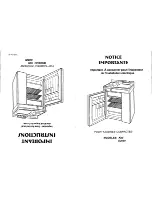
CARE AND CLEANING
Outside
Inside
The door handles and trim can be cleaned with a
Inside the fresh food and frozen food storage
cloth dampened with solution of mild liquid
dishwashing detergent and water. Dry with a soft
cloth. Don’t use wax on the door handles and trim.
Keep the finish clean. Wipe with a clean cloth lightly
dampened with kitchen appliance wax or mild liquid
dishwashing detergent. Dry and polish with clean,
soft cloth. Do not wipe the refrigerator with a soiled
dishwashing cloth or wet towel. These may leave a
residue that can erode the paint. Do not use scouring
pads, powdered cleaners, bleach or cleaners
containing bleach because these products can scratch
and weaken the paint finish.
Protect the paint finish. The finish on the outside of
the refrigerator is a high quality, baked-on paint finish.
With proper care, it will stay new-looking and rust-free
for years. Apply a coat of kitchen/appliance wax when
the refrigerator is new and then at least twice a year.
Appliance Polish Wax & Cleaner (Cat. No.
16)
is available from GE Appliance Service and Parts Centers.
compartments should be cleaned at least once a year.
Unplug the refrigerator before cleaning. If this is not
practical, wring excess moisture out of sponge or
when cleaning around switches, lights or controls.
Use warm water and baking soda solution—about
tablespoon of baking soda to a quart of water. This
both cleans and neutralizes odors. Rinse thoroughly
with water and wipe dry. Other parts of the
refrigerator, including door gasket, vegetable drawer,
ice trays and all plastic parts, can be cleaned the same
way. Do not use cleansing powders or other abrasive
cleaners. To help prevent odors, leave an open box of
baking soda in the rear of the refrigerator, on the top
shelf. Change the box every three months. An open
box of baking soda in the frozen food storage
compartment will absorb stale odors.
plastic parts from your refrigerator
your
dishwasher.
Defrosting
Defrost whenever frost becomes 1/4” to 1/2” thick.
Never use a sharp or pointed instrument to remove
frost as it may result in damage to the cooling coils.
Use of a plastic scraper is recommended. Do not use
any electrical device in defrosting your refrigerator.
To Defrost:
●
Remove foods from frozen food storage
compartment and chiller tray. To reduce the amount
of thawing of frozen food while defrosting the
frozen food storage compartment, store the food in a
picnic cooler or other insulated container.
●
Turn temperature control to “OFF”.
●
Place pans of hot water in frozen food storage
compartment to speed melting of ice.
After Defrosting:
●
Empty water from chiller tray.
. Wash chiller tray in warm water and wipe frozen
food storage compartment with a damp cloth.
●
Remove vegetable pan and wipe up spills in bottom
of refrigerator.
CAUTION: Do not touch refrigerator coils or
refrigerating surfaces, particularly when hands are
damp or wet.
Light Bulb Replacement
Beneath and Behind the Refrigerator
A 40-watt appliance bulb and socket are located
In the refrigeration process, it is normal that heat be
behind the light shield next to the temperature control.
expelled in the area under the refrigerator. Some
To replace a burned-out bulb, reach in behind the light
synthetic floor coverings will discolor at these
switch, unscrew the bulb, and screw in a same-size,
normal and safe operating temperatures. Your floor
same-type bulb.
covering supplier should be consulted if you object
to this discoloration.
Care should be taken in moving your refrigerator
away from the wall. All types of floor coverings can
be damaged, particularly cushioned coverings and
those with embossed surfaces.
6






























